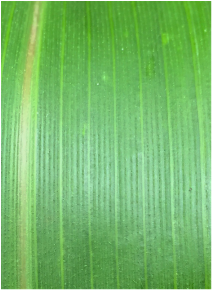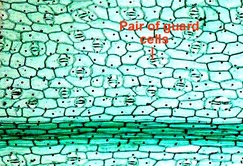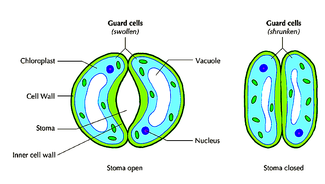|
Seedlings are now, in US corn belt, growing roots from the first stem nodes. Near the root tip new primordia are initiated, from which lateral roots can grow. The number of lateral roots is affected by genetics and environment. There is a tendency for fewer if soil is exceptionally dry, resulting in more extension downwards of the secondary roots. More lateral roots have some advantage for reducing root lodging but also comes at some energy cost in that because each of the new root tips draws more energy from the leaves. On the other hand, the deeper growth of the main roots is most likely to reach deeper water reserves. More information available at www.plantphysiol.org/cgi/doi/10.1104/pp.15.00187.
I personally witnessed this phenomenon in 1980. A hybrid (A) was frequently noted as having high yields in many environments but in the very dry year of 1980 it was outstandingly higher yielding including much better than its widely used competitor hybrid (B). Demand for hybrid A skyrocketed. 1981 was a near opposite season for water. Hybrid B did very well whereas Hybrid A had decent ears but root lodged badly only shortly after pollination. The drought resistance obtained by having deeper roots but fewer lateral roots was good under dry conditions but Hybrid B, with its tendency to have more lateral roots was better when the topsoil was exceptionally wet for most of the summer, especially as minimal till placed much organic matter in those top layers. Like most aspects of corn, we look for a balance of structures appropriate for that season’s condition and no hybrid seems to be at its best every year. Primary roots, developing from the corn seed are temporary. Direction of the growth downward is affected by auxins originating in the growing embryo. By the time the first leaves emerge to light, however, much of the auxin production comes from the leaf tips. These plant hormones, along with a few others, are transported quickly through the phloem sieve cells along with carbohydrates and protein, to the root tips, uninhibited by cell membranes. Root tip cells, with less developed cell walls but with membranes do require active transport, and energy, to move the auxins into these newly developing cells.
Root tips cells are meristematic, dividing and producing new cells at a near constant rate in corn up until pollination. New cells on the outside layer (epidermis) of the root are stimulated by the auxins to produce lateral extensions called root hairs. These cell extensions large vacuoles allow active osmosis effectively increasing the absorption of water and minerals. Root hairs only remain active for a 2-14 days, but the continuously dividing root tip cells produce new ones in the newest epidermal cells. Movement of auxins to the epidermal cells does involve other hormones and proteins with several genetics with several environmental influences. For example, studies have shown that decreasing soil moisture results in production of more root hairs in corn. Given the wide genetic variability of corn, surely varieties differ in this response. The veins are parallel to each other in the corn leaves. At the base of the leaf, where it connects to the stem at the node, the system becomes much more complex. The vascular tissue goes horizontal with fusions between the individual veins. Also, the xylem ‘tubes’, (vessels) have end walls, forcing the water moving up from roots and stem through small pores that act as filters. The pores are sufficiently small to filter out any particles being carried upward with the water. Many bacteria and even some viruses are too large to pass through the pores. Each node of corn, even in the small seedling, has this complexity of the vascular tissue. Root vascular tissue connects with the stem vascular system at the first leaf node. Whereas an individual leaf may have up to 20 main veins, the node may have 100 horizontal vascular bundles and with fusion of vessels at the nodes. This redundancy protects the plants from a problem in single vascular bundle or one root branch from blocking transport of water and minerals to the leaves. Likewise, the movement of carbohydrates from leaves to roots gets distributed to all roots. Water soluble substances such as minerals and toxins can move freely up the plant with water through the xylem but most fungal spores and bacteria are filtered out by the pores.
As a consequence of the entanglement of the vascular system at nodes, infection of by a bacterium such as the cause of Goss Wilt or Stewart’s disease usually causes lesions from the point of infection to the end of the leaf but does not cause lesions on other leaves. However, toxins of fungi such as race 1 of Bipolaris zeicola and race T of Bipolaris maydis can be distributed to other leaves. A few pathogens, such as those causing crazy top and smut get to the top of the plant by reaching the growing point early in development and essentially get carried along as those cells divide, but that’s another story. The nodal arrangement of vascular tissue keeps most pathogens from becoming systemic.
Cells between the upper and lower epidermis of corn leaves make up the mesophyll and the vascular bundles (veins). These cells carry out many normal cell functions of producing proteins and anti-pathogen substances but most notable is the photosynthesis performed in the chloroplasts. Most (95%) plant species have mesophyll cells located immediately adjacent to the epidermis. These species have a C3 system of photosynthesis. This system obviously works ok even with some inefficiency in the final conversion to sugar. However, this inefficiency results in excess water consumption for that final step and even higher use of oxygen instead of releasing it to the environment. The problem is accelerated at higher temperatures in which more oxygen is consumed and less sugar produced.
Some plant species of tropical origin, such as the Teosinte species from which corn was developed, separated the photosynthesis two steps making the process more efficient even when under tropical conditions. With a change in the enzymes involved, the first step finishes with a 4 carbon ring instead of a 3 carbon ring. This compound is then moved to another cell’s chloroplasts for the final combination with carbon dioxide molecules and production of sugar. In C4 plants like corn, the mesophyll cells are not lined up close to the epidermis but dispersed closer to the vascular bundles where that second stage of sugar production takes place. Bundle sheath cells, in C4 plants, have the specialized chloroplasts that make the final product. Being adjacent to the mesophyll cells is essential to the efficiency of the process. The effect of this cell arrangement and the slight change in enzymes in the chloroplasts of C4 plants and participation of the bundle sheath cells allows corn to become a greater user of light intensity than most crops. Whereas photosynthesis in soybeans and wheat peaks out at about 3000 ft candles (32000 lux) of light intensity, photosynthesis rate in corn increases to the brightest of sunlight (10000 ft candles or 107000 lux). It also explains why corn photosynthetic rates decreases with slight changes in light intensity such as shading within the canopy as well with clouds. On the other hand, this cell arrangement and unique photosynthesis process makes corn one of our best crops at removing CO2 from the atmosphere and for storage of chemical energy captured from the sun.
After emergence and successful elongation of the first true leaves, photosynthesis becomes the energy source for future growth. Consistent with its tropical origin, corn photosynthesis is negatively affected by low temperatures. Leaves grown at 14°C (57°F) have 30% of the photosynthesis rate as those grown at 25°C (77°F). (Plant Physiol. (1995) 108: 761-767). Much of this reduction is recovered within a few hours if the leaves are returned to the higher mid-70 temperatures.
Light energy absorbed by chlorophyll causes an electron to be moved within the chloroplast but if it does not ultimately get utilized in synthesis of carbohydrates, it can damage a critical protein needed in photosynthesis. Corn chloroplasts react by producing a yellow pigment (zeaxanthin) protein that is active in the quick recovery after the heat returns. Chlorophyll molecules are relatively unstable especially in high light intensity and low temperatures, further contributing to reduced photosynthesis at the lower temperatures. Another protection system in corn, and other plants, that develops in the cell outside of the chloroplast is the pigment anthocyanin. This red pigment absorbs the blue light spectrum of sunlight and thus reduces photosynthesis. Anthocyanin forms after the sugars reach a high concentration. This often happens in seedlings when sugars are unable to be translocated to the roots, again because lack of the heat energy needed move the sugars. Hybrids vary in the tendency to produced anthocyanin, occasionally causing alarm to the grower but return to warmer temperatures results in disappearance of the red color and normal photosynthetic rates in the seedling leaves. Growth of the corn plant, beginning with germination and emergence from the soil, is mostly due to cell elongation. This requires a combination of water pressure within cells, softened cell walls and eventual production of new cell wall components. The water pressure is basically a physical phenomenon. Water moves through cell walls and membranes from a high concentration of water (i.e. few solutes) to the low concentration within the cells. The physiological components such as production of hormones related to softening of cell walls and building of new membranes and other components of the expanded cells are more dependent on metabolism. This can be affected by outside factors such as temperature.
This conflict between water pressure on cells and difficulty with metabolism at low temperatures can cause slow emergence in wet, cold soils and, occasionally, some deformed seedlings that never do emerge. Damage can also lead to more infection by the few fungi such as Pythium species that are favored by low temperatures. It is not well understood why these factors seems to result in twisted seedlings growing from a few seeds whereas adjacent seeds produce normal emergence. It could be because the water is pressuring the cell elongation but the metabolism is unable to adequately accommodate with production of cell wall materials. Were the individual seeds damaged, soil components surrounding those seeds causing growth stress, or growth hormone herbicide concentration or pathogens involved? It does become difficult to troubleshoot because it often is a complicated mix of variables. Regardless, the late-emerging plants rarely perform as well as the early-emergers. Sometimes this start of the season is forgotten when final yields are compared 6 months later. |
About Corn JournalThe purpose of this blog is to share perspectives of the biology of corn, its seed and diseases in a mix of technical and not so technical terms with all who are interested in this major crop. With more technical references to any of the topics easily available on the web with a search of key words, the blog will rarely cite references but will attempt to be accurate. Comments are welcome but will be screened before publishing. Comments and questions directed to the author by emails are encouraged.
Archives
December 2021
Categories
|




 RSS Feed
RSS Feed